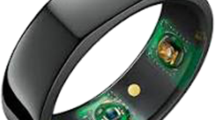Abstract
The development of sleep medication, computer technologies, and microelectronics in the past decade brought about the creation of a new class of instruments for the diagnostics of sleep disorders, i.e., computerized polysomnographic systems. The application of the IBM PC PENTIUM using the MS Windows system for software development and standard hardware and software allows a user to economically supplement the basic equipment of the instrument with novel advanced programs. The possibilities of the application of algorithms of the manual and automated methods of sleep analysis for research purposes are discussed.
Similar content being viewed by others
REFERENCES
Principles of Psychophysiology: Physical, Social and Inferential Elements, Cacioppo, J.T. and Tassinary, L.G., Eds., New York: Cambridge Univ. Press, 1990.
Danilova, N.N., Psikhofiziologiya: Uchebnik dlya vuzov (Psychophysiology: a Higher Education Handbook), Moscow: Aspekt, 1998.
Kutas, M. and Federmeier, K.D., Minding the Body, Psychophysiology, 1998, vol. 35, p. 135.
Dorokhov, V.B. and Nuer, M.R., Topographic Brain Mapping. Methodological Problems, Fiziol. Chel., 1992, vol. 18, no. 6, p. 16.
Doroknov, V.B., Application of Computerized Polysomnography in Psychophysiological and Clinical Research, Materialy XVIII S'ezda Fiziologicheskogo Obshchestva im. I.P. Pavlova, Kazan, 2001, p. 79.
Dorokhov, V.B., Psychophysiological Mechanisms of Activity Disorders in Somnolent States of Consciousness,Materialy 1 Rossiiskoi shkoly-konferentsii po fundamental'nym i prirkadnym problemam somnologii “Son-okno v mir bodrstvovaniya”, Moscow, 2001, p. 25.
Vein, A.M. and Hecht, K., Son cheloveka. Fiziologiya i patologiya (Human Sleep. Physiology and Pathology), Moscow: Meditsina, 1989.
Romanov, A.I., Meditsina sna (Sleep Medicine), Moscow: Slovo, 1998.
Kallistov, D.Yu. and Romanov, A.I., Instrumental Diagnostics of Sleep Disorders: Indications and Standardization Problems, Kremlevskaya Meditsina (Klinicheskii Vestn. Tematicheskii vypusk: Somnologiya), 1998, p. 42.
Belov, A.M., Analiz protsessa sna pri polisomnografii (Analysis of Sleep in Polysomnography), Moscow, 2000.
American Sleep Disorders Association. Practice Parameters for the Indications for Polysomnography and Related Procedures,Sleep, 1997, vol. 20, p. 406.
Rechtschaffen, A. and Kales, A., A Manual of Standardized Terminology, Techniques and Scoring System for Sleep Stages of Human Subjects, Washington, DC: National Institute of Health Publications, 1968, no. 204.
Vein, A.M., Bodrstvovanie i son (Wakefulness and Sleep), Moscow: Nauka, 1979.
Levin, Ya.I., Gasanov, R.L., and Vein, A.M., Cerebral Asymmetry and Sleep, Materialy XXX Vserossiiskogo soveshchaniya po problemam vysshei nervnoi deyatel'nosti (Proc. 30th Russian Conf. on the Problems of Higher Nervous Activity), St. Petersburg, 2000, p. 646.
15. 1-ya Rossiiskaya shkola-konferentsiya po fundamental'nym i prirkadnym problemam somnologii “Son- okno v mir bodrstvovaniya”, Moscow, 2001.
Karmanova, I.G. and Oganesyan, G.N., Fiziologiya i patologiya tsikla bodrstvovanie-son (Physiology and Pathology of Sleep-Wakefulness Cycle), St. Petersburg: Nauka, 1994.
Shepoval'nikov, A.N., Aktivnost' spyashchego mozga (Activity of Sleeping Brain), Leningrad: Nauka, 1986.
Babak, S.L., Golubev, L.A., and Grigor'yants, R.A., Rasstroistva dyhkaniya vo vremya sna (Respiration Disorders during Sleep), Moscow, 1999.
Kel'manson, I.A., Narusheniya dykhaniya vo sne u detei (Respiration Disorders during Sleep in Children), St. Petersburg: Spetsial'naya Literatura, 1997.
Kuraev, G.A. and Suntsova, N.V., Interhemispheric Relations at Different Stages of Human Sleep-Wakefulness Cycle, Fiziol. Chel., 1998, vol. 24, no. 5, p. 72.
Dorokhov, V.B., Dementienko, V.V., Koreneva, L.G., et al., Electrodermal Indices of Subjective Perception of Errors during Activity in Drowsy Consciousness Changes, Zh. Vyssh. Nervn. Deyat. im. I.P. Pavlova, 2000, vol. 50, no. 2, p. 206.
Hiroshige, Y. and Dorokhov, V.B., Hemispheric Asymmetry and Regional Differences in Electroencephalographic Alpha Activity at the Wake-Sleep Transition, Japanese Psychol. Res., 1997, vol. 39, no. 2, p. 75.
Koval'son, V.M., Psychophysiology of Sleep on the Threshold of the Third Millennium, Materialy XXX Vserossiiskogo soveshchaniya po problemam vysshei nervnoi deyatel'nosti (Proc. 30th Russian Conf. on the Problems of Higher Nervous Activity), St. Petersburg, 2000, p. 641.
Sokolov, E.N., Perception and the Conditioned Reflex, New York: Macmillan, 1963.
Frolov, M.V., Kontrol' funktsional'nogo sostoyaniya cheloveka-operatora (Control of the Functional State of a Man-Operator), Moscow: Nauka, 1987.
Symposia “Driver Sleepiness”, Third International Congress of the WFSRS, Dresden (Germany), 1999.
Wake up, America. A National Sleep Alert, A Report of the National Commission on Sleep Disorders Research, 1993, January.
Guidelines for Digital EEG. International Organization of Societies for Electrophysiological Technology (OSET), Am. J. END Technol. ASET, Iowa, 1999, vol. 39, p. 278.
Vein, A.M. and Eligulashvili, T.S., Sleep Medicine, Materialy XXX Vserossiiskogo soveshchaniya po problemam vysshei nervnoi deyatel'nosti (Proc. XXX Russian Conf. on the Problems of Higher Nervous Activity), St. Petersburg, 2000, p. 637.
Levin, Ya.I. and Artemenko, A.R., Fototerapiya (Phototherapy), Moscow: Tri L, 1996.
Shevelev, I.A., Infrakrasnaya termografiya (Infrared Thermography), Moscow: Nauka, 1994.
Author information
Authors and Affiliations
Rights and permissions
About this article
Cite this article
Dorokhov, V.B. Application of Computerized Polysomnographic Systems in Psychophysiology and Clinical Studies. Human Physiology 28, 233–239 (2002). https://doi.org/10.1023/A:1014874703353
Issue Date:
DOI: https://doi.org/10.1023/A:1014874703353




